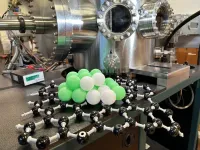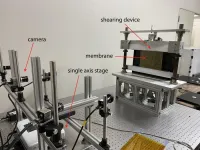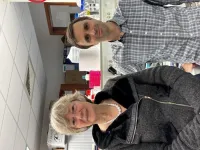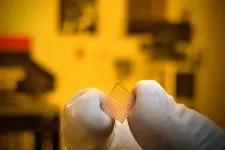(Press-News.org) UNDER EMBARGO UNTIL 10 AM GMT / 5 AM ET THURSDAY 9 JANUARY 2025
Pioneering new mathematical model could help protect privacy and ensure safer use of AI
AI tools are increasingly being used to track and monitor us both online and in-person, yet their effectiveness comes with big risks. Computer scientists at the Oxford Internet Institute, Imperial College London, and UCLouvain have developed a new mathematical model which could help people better understand the risks posed by AI and assist regulators in protecting peoples’ privacy. The findings have been published today (9 January) in Nature Communications.
For the first time, the method provides a robust scientific framework for evaluating identification techniques, especially when dealing with large-scale data. This could include, for instance, monitoring how accurate advertising code and invisible trackers are at identifying online users from small pieces of information such as time zone or browser settings (a technique called ‘browser fingerprinting’).
Lead author Dr Luc Rocher, Senior Research Fellow, Oxford Internet Institute, part of the University of Oxford, said: “We see our method as a new approach to help assess the risk of re-identification in data release, but also to evaluate modern identification techniques in critical, high-risk environments. In places like hospitals, humanitarian aid delivery, or border control, the stakes are incredibly high, and the need for accurate, reliable identification is paramount.”
The method draws on the field of Bayesian statistics to learn how identifiable individuals are on a small scale, and extrapolate the accuracy of identification to larger populations up to 10x better than previous heuristics and rules of thumb. This gives the method unique power in assessing how different data identification techniques will perform at scale, in different applications and behavioural settings. This could help explain why some AI identification techniques perform highly accurately when tested in small case studies but then misidentify people in real-world conditions.
The findings are highly timely, given the challenges posed to anonymity and privacy caused by the rapid rise of AI-based identification techniques. For instance, AI tools are being trialled to automatically identify humans from their voice in online banking, their eyes in humanitarian aid delivery, or their face in law enforcement.
According to the researchers, the new method could help organisations to strike a better balance between the benefits of AI technologies and the need to protect people's personal information, making daily interactions with technology safer and more secure. Their testing method allows for the identification of potential weaknesses and areas for improvement before full-scale implementation, which is essential for maintaining safety and accuracy.
Co-author Associate Professor Yves-Alexandre de Montjoye (Data Science Institute, Imperial College, London) said: “Our new scaling law provides, for the first time, a principled mathematical model to evaluate how identification techniques will perform at scale. Understanding the scalability of identification is essential to evaluate the risks posed by these re-identification techniques, including to ensure compliance with modern data protection legislations worldwide.”
Dr Luc Rocher concluded: “We believe that this work forms a crucial step towards the development of principled methods to evaluate the risks posed by ever more advanced AI techniques and the nature of identifiability in human traces online. We expect that this work will be of great help to researchers, data protection officers, ethics committees, and other practitioners aiming to find a balance between sharing data for research and protecting the privacy of patients, participants, and citizens.”
Notes to editors:
For media inquiries and interview requests, contact: press@oii.ox.ac.uk
The study ‘A scaling law to model the effectiveness of identification techniques’ will be published in Nature Communications at 10 am GMT / 5 am ET on Thursday 9 January 2025 at https://www.nature.com/articles/s41467-024-55296-6
To view a copy of the paper before this, under embargo, contact: press@oii.ox.ac.uk
About the Research
The work by was supported by a grant awarded by to Luc Rocher by Royal Society Research Grant RG\R2\232035, the John Fell OUP Research Fund, the UKRI Future Leaders Fellowship [grant MR/Y015711/1], and by the F.R.S.-FNRS. Yves -Alexandre de Montjoye acknowledges funding from the Information Commissioner Office. The funders which had no role in the study design, data collection and analysis, decision to publish, or preparation of the article.
About the Oxford Internet Institute (OII)
The Oxford Internet Institute (OII) is a multidisciplinary research and teaching department of the University of Oxford, dedicated to the social science of the Internet. Drawing from many different disciplines, the OII works to understand how individual and collective behaviour online shapes our social, economic and political world. Since its founding in 2001, research from the OII has had a significant impact on policy debate, formulation and implementation around the globe, as well as a secondary impact on people’s wellbeing, safety and understanding. Drawing on many different disciplines, the OII takes a combined approach to tackling society’s big questions, with the aim of positively shaping the development of the digital world for the public good. https://www.oii.ox.ac.uk/
About the University of Oxford
Oxford University has been placed number 1 in the Times Higher Education World University Rankings for the ninth year running, and number 3 in the QS World Rankings 2024. At the heart of this success are the twin-pillars of our ground-breaking research and innovation and our distinctive educational offer. Oxford is world-famous for research and teaching excellence and home to some of the most talented people from across the globe. Our work helps the lives of millions, solving real-world problems through a huge network of partnerships and collaborations. The breadth and interdisciplinary nature of our research alongside our personalised approach to teaching sparks imaginative and inventive insights and solutions.
Through its research commercialisation arm, Oxford University Innovation, Oxford is the highest university patent filer in the UK and is ranked first in the UK for university spinouts, having created more than 300 new companies since 1988. Over a third of these companies have been created in the past five years. The university is a catalyst for prosperity in Oxfordshire and the United Kingdom, contributing £15.7 billion to the UK economy in 2018/19, and supports more than 28,000 full time jobs.
END
Pioneering new mathematical model could help protect privacy and ensure safer use of AI
2025-01-09
ELSE PRESS RELEASES FROM THIS DATE:
Floods, droughts, then fires: Hydroclimate whiplash is speeding up globally
2025-01-09
Key takeaways
Hydroclimate whiplash – rapid swings between intensely wet and dangerously dry weather – has already increased globally due to climate change, with further large increases expected as warming continues, according to a team of researchers led by UCLA’s Daniel Swain.
The “expanding atmospheric sponge,” or the atmosphere’s ability to evaporate, absorb and release 7% more water for every degree Celsius the planet warms, is a key driver of the whiplash.
Co-management of extreme rainfall or extreme droughts, ...
Scientists fuel sustainable future with catalyst for hydrogen from ammonia
2025-01-09
Scientists have created a catalyst for hydrogen generation from ammonia that becomes more active with time, and by counting atoms revealed changes that boost the catalyst’s performance.
A research team from the University of Nottingham's School of Chemistry, in collaboration with the University of Birmingham and Cardiff University, has developed a novel material consisting of nanosized ruthenium (Ru) clusters anchored on graphitized carbon. These Ru nanoclusters react with ammonia molecules, catalysing splitting ammonia into ...
Discovering hidden wrinkles in spacecraft membrane with a single camera
2025-01-09
Exiting Earth’s gravity takes an enormous amount of fuel and power. Due to this, spacecraft strapped to rockets are limited in their carry capacity and every gram must be accounted for. To lighten the load, thin membranes are being researched as alternative materials, but their plastic wrap property causes wrinkling that can affect operational performance. For this reason, there is a need to develop measurement technology that can accurately detect deformations.
Professor Takashi Iwasa at Osaka Metropolitan University’s Graduate School of Engineering led a team in developing a method for measuring the size of wrinkles ...
Women are less likely to get a lung transplant than men and they spend six weeks longer on the waiting list
2025-01-09
Women are less likely to receive a lung transplant and spend an average of six weeks longer on the waiting list, according to a study published today (Thursday) in ERJ Open Research [1]. However, women who receive a lung transplant are more likely than men to live for five years post-transplant. Based on their findings, the researchers encourage changes in regulation and clinical guidelines to address this inequality.
Lung transplantation is the only treatment for people with end-stage respiratory failure and patients on the waiting list have a high risk ...
Study sheds more light on life expectancy after a dementia diagnosis
2025-01-09
The average life expectancy of people diagnosed with dementia ranges from 9 years at age 60 to 4.5 years at age 85 for women and from 6.5 to just over 2 years, respectively, in men, finds a systematic review of the latest evidence in The BMJ today.
The results also suggest that one third of people with dementia are admitted to a nursing home within three years of diagnosis.
Nearly 10 million people worldwide receive a diagnosis of dementia every year, but survival estimates vary widely, and few ...
Tesco urged to drop an “unethical” in-store infant feeding advice service pilot
2025-01-09
UK supermarket giant Tesco is being urged to drop an “unethical” pilot of an in-store infant feeding advice service in which Danone-funded midwives are expected to wear branded uniforms and undergo training by the formula company, reveals an exclusive news report published by The BMJ today.
Critics say that the initiative, running in Tesco’s flagship store and set to be rolled out shortly, is a backward step and reminiscent of the “milk nurses” scandal of the 1970s, where formula industry salespeople dressed as nurses and promoted formula milk to parents.
One midwife hired by Danone quit ...
Unraveling the events leading to multiple sex chromosomes using an echidna genome sequence
2025-01-09
Unraveling the Events Leading to Multiple Sex Chromosomes Using an Echidna Genome Sequence
A nearly gapless genome sequence of the echidna, an egg-laying mammal with multiple sex chromosomes, helps researchers to track genomic reorganization events that gave rise to a highly unusual sex determination system.
The short-beaked echidna (Tachyglossus aculeatus) is one of Australia’s most iconic animals. Belonging to a unique group of mammals called “monotremes” (with the platypus as the other prominent member). Echidnas may at first glance be mistaken for a weird-looking hedgehog, ...
New AI platform identifies which patients are likely to benefit most from a clinical trial
2025-01-08
A new study led by Winship Cancer Institute of Emory University and Abramson Cancer Center of University of Pennsylvania researchers demonstrates that a first-of-its-kind platform using artificial intelligence (AI) could help clinicians and patients assess whether and how much an individual patient may benefit from a particular therapy being tested in a clinical trial. This AI platform can help with making informed treatment decisions, understanding the expected benefits of novel therapies and planning ...
Unique Stanford Medicine-designed AI predicts cancer prognoses, responses to treatment
2025-01-08
The melding of visual information (microscopic and X-ray images, CT and MRI scans, for example) with text (exam notes, communications between physicians of varying specialties) is a key component of cancer care. But while artificial intelligence helps doctors review images and home in on disease-associated anomalies like abnormally shaped cells, it’s been difficult to develop computerized models that can incorporate multiple types of data.
Now researchers at Stanford Medicine have developed an AI model able to incorporate visual ...
A new ultrathin conductor for nanoelectronics
2025-01-08
As computer chips continue to get smaller and more complex, the ultrathin metallic wires that carry electrical signals within these chips have become a weak link. Standard metal wires get worse at conducting electricity as they get thinner, ultimately limiting the size, efficiency, and performance of nanoscale electronics.
In a paper published Jan. 3 in Science, Stanford researchers show that niobium phosphide can conduct electricity better than copper in films that are only a few atoms thick. Moreover, these films can be created and deposited at sufficiently low temperatures to be compatible with modern computer ...




